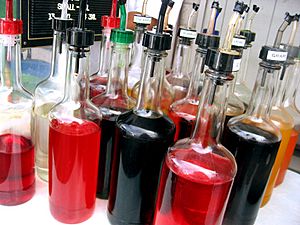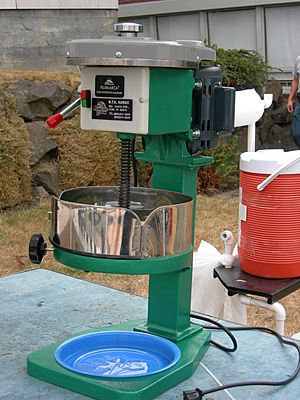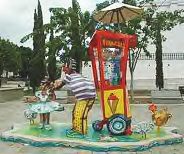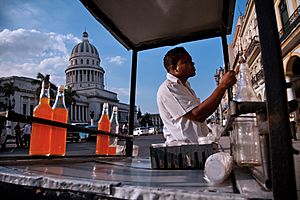Shaved ice facts for kids
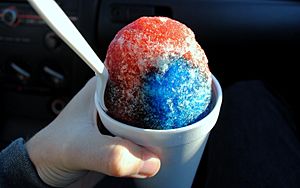
Snow cone: shaved ice with flavored syrup
|
|
| Type | Frozen dessert |
|---|---|
| Course | |
| Main ingredients | |
Shaved ice is a cool dessert made from tiny pieces of ice or finely crushed ice. It's usually topped with sweet syrups or other tasty things. The syrup is often added after the ice is shaved, like when you buy it from a vendor. Sometimes, the flavor is even added before the ice is frozen. People all over the world enjoy shaved ice in many different ways. You can also mix shaved ice with lots of liquid to make a drink.
Many people confuse shaved ice with "Italian ice" or "water ice." Italian ice often has its flavor, like fruit juice, mixed into the water before it freezes. But with regular shaved ice, especially from street vendors, the flavor is usually added after the ice is already frozen and shaved. Snow cones are a good example of this.
Contents
History of Shaved Ice
The first time we know about a "shaved ice" dessert was way back in 27 B.C.E. The Roman Emperor Nero had his helpers bring snow from nearby mountains. He then flavored it with a mix of fruit and honey.
In ancient Japan, this dessert was only for kings and queens. It was made from natural ice that formed in the coldest part of winter. This ice was kept in special icehouses. Because it was so rare, only rich people from the Heian period could enjoy it. Regular people couldn't afford it.
Halo-halo is a Filipino version of the Japanese kakigori dessert. It's thought to have come from Japanese people who moved to the Philippines before World War II. The first versions had only cooked red beans or mung beans with crushed ice, sugar, and milk. This was called "mongo-ya". Over time, more local ingredients were added, creating the halo-halo we know today. Some say halo-halo was invented by Japanese migrants in the 1920s or 1930s. They were near the Insular Ice Plant in Quiapo, Manila, which supplied ice to the city.
When Japanese people moved to Hawaii, they brought this tradition with them. Just like in Rome and Japan, Hawaii has warm areas close to snow-capped mountains. This means snow can be brought down without melting too quickly.
Shaved Ice Around the World
You can find many types of shaved ice all over the world. Asia is a very popular place for these treats.
Shaved Ice in the Americas
In Latin America, shaved ice desserts often have influences from North American cultures. Many Spanish names for it include raspado (meaning "scraped ice"), or granizado (from a word meaning hailstone).
North America and the Caribbean
- In Canada and most of the contiguous United States, shaved ice is called "Snow cones" or "Snowballs." It's crushed or shaved ice with sweet fruit-flavored syrup on top.
- In New Orleans, snowballs often have fruit syrup or a fruit-cream syrup mix.
- Baltimore snowballs often have fruit syrup and are topped with marshmallow cream.
- A Sno-ball in New Orleans can have syrup, ice cream, condensed milk, and other toppings.
- In the United States Virgin Islands, a similar dessert is called "fraco" (pronounced fray-co).
- In Cuba and Cuban areas of the United States, shaved ice is called "granizados." They are often sold from ice cream trucks. A classic Cuban flavor is anise, which comes from the star anise spice.
- In the Dominican Republic, snow cones are called "frío frío" (meaning "cold cold") or "Yun Yun."
- In Hawaii, they are known as "Hawaiian shave ice" or just "Shave ice." They often look like East Asian versions. Toppings like condensed milk, adzuki beans, or mochi balls are common. A scoop of vanilla ice cream is often put at the bottom.
- In Mexico and parts of the Southwestern United States, shaved ice with syrup is called a "raspa" or "raspado." Raspados come in many fruit flavors and classic Mexican flavors. These include leche (sweet milk with cinnamon), picosito (lemon and chili powder), chamoy (fruits and chili sauce), cucumber, guanabana, guava, pistachio, and tamarind.
- In most of Puerto Rico, they are called "Piragua." This is because they are made in pyramid shapes, and agua means water in Spanish. In western Puerto Rico, they are called "raspao." Many Puerto Rican vendors use street carts. You can often find "piragua" carts in Puerto Rican neighborhoods, especially in New York City and Philadelphia, during summer.
Central and South America
- In Bolivia, they are known as "Shikashika." The ice for these is collected from nearby mountains.
- "Mermelada con hielo" (ice jam) is a popular treat in Rancagua, central Chile.
- In Colombia, Panama, Nicaragua and Venezuela, they are called "Raspados" or "Raspaos." They are topped with condensed milk and fruit flavors.
- In Costa Rica, they are called "granizados" or "copos" (like snowflakes). In the Puntarenas Province, if they have ice cream on top, they are called "churchills."
- In Ecuador, there are three types. "Raspados" are sold from street carts and have ice shaved by hand. "Granizados" are also from street carts, have ice crushed by a hand-cranked machine, and are topped with condensed milk. "Granizados" sold in stores have very fine ice from an electric machine. Street versions are much cheaper.
- In El Salvador, they are known as "Minutas."
- In Guatemala, they are called "Granizada" and are topped with condensed milk and fruit.
- In Guyana, they are known as "Crush Ice" or "Snow Cone" and are topped with condensed milk.
- In Peru, they are known as "raspadilla." It's ground ice topped with different fruit juices. Common flavors are pineapple and strawberry. It can also have berry juice, passion fruit juice, or purple corn juice (chicha morada). Sometimes, it's topped with condensed milk or yogurt. It's very popular at beaches in summer. Vendors often grind the ice from a block right in front of you.
- In Brazil, they are called "raspa-raspa'" or "raspadinha." Some parts of the country call it "Gelo ralado com groselha" (redcurrant). Vendors shave the ice from a block. Common flavors include strawberry, coconut, bubblegum, grape, mint, passion fruit, and Tutti frutti.
Shaved Ice in Asia
East and Southeast Asia
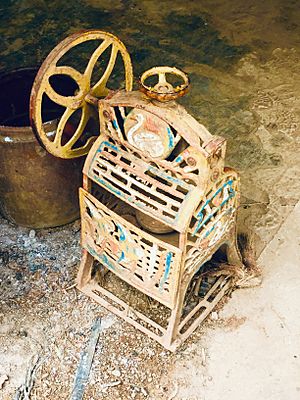
In East Asia, shaved ice desserts are not just flavored with syrup. People often add solid things like red bean paste, jellies, canned fruits, jams, and sweetened condensed milk. This adds different textures to the dessert.
- In Taiwanese cuisine, it's called "Tshuah-ping" or "Bàobīng". There are many types in Taiwan. Some have canned fruits, fruit syrup, and condensed milk. Baobing is one of the oldest shaved ice treats, going back to China in the 7th century. It's usually served in big portions with many toppings.
- In Japan, the ice is called "Kakigōri." It's topped with fruit-flavored or plain syrup. Some places use two or more syrups for colorful treats. Condensed milk is often poured on top. Kakigōri is sold almost everywhere in Japan during the hot summer. Some coffee shops add ice cream, dango, and red bean paste. You can also find it pre-packaged in convenience stores.
- In Korea, shaved ice is called "Bingsu." The kind with sweetened red beans is called pat-bingsu. Pat means "red bean." Other toppings can include fresh fruits and soybean powder. The first forms of bingsu were around during the Joseon dynasty (1392–1897). Officials would share crushed ice with fruits from a special ice storage place. A very popular type since 2014 is snow flower bingsu ("눈꽃빙수"). It's made of very finely shaved ice that feels like real snowflakes. Also, milk is added to the ice, so it has a milky flavor.
- In Cambodia, shaved ice is known as Teuk Kork Chus (ទឹកកកឈូស). It's usually eaten on hot summer days and during Cambodian New Year. Teuk means water, Kak means ice, and Chhous means shaved. This dessert has many fillings like jelly, basil seeds, jackfruit, taro, and red beans. After the fillings, shaved ice is added, then customers choose colored syrups (green, red, or blue). Finally, condensed milk is poured on top.
- In Malaysia and Singapore, it's called "ais kacang." It has shaved ice topped with colorful, sweet syrups, condensed milk, and evaporated milk. Sometimes, durian pulp or vanilla ice cream is added. Under the ice, you'll usually find sweetened red beans, canned fruit, attap seeds, and grass jelly. Electric ice shavers are often used, but some vendors still use a hand blade for a rougher texture. A similar dessert is Cendol, which is shaved ice with sweet green noodles made from rice flour, drizzled with palm sugar. It often comes with kidney beans and sweetcorn.
- In Indonesia, it's called "es campur." It's similar to the Malaysian/Singaporean ais kacang.
- In the Philippines, it's called Halo halo. It has shaved ice topped with sweetened beans and fruits, creme caramel (flan), nata de coco, and ice cream. "Halo-halò" means "mix-mix" in Tagalog. It's also found in mais con yelo.
- In Thailand, this cold dessert is called "namkhaeng sai" (น้ำแข็งไส). It's served with many toppings like red beans, toddy palm seeds, sticky rice, jellies, and preserved fruits, often coconut. Red syrup and condensed milk are poured generously on top. In other Thai desserts, the mixings are at the bottom, and shaved ice is scooped on top. There are 20–30 different mixings you can choose from.
South Asia
In South Asia, snow cones are a cheap and popular summer treat. They are often shaved by hand.
- In India, they are called Gola or Chuski. They are flavored with sugar syrups, fruit flavors, and local tastes like rose, khus, or kala-khatta. Condensed milk is often added on top. In many parts of India, it's called "Ball of ice." A similar shaved ice is found in northern Kerala called Ice Orathi.
- In Pakistan, it's often called Gola ganda (Urdu: گولا گنڈا). It's flavored with many sugar syrups, fruits, condensed milk, ice cream, nuts, rosewater, and other toppings. It's a very popular street food.
Middle East
- In Israel, shaved ice is called 'Barad'. This is the Hebrew word for hail. It's more like a slush drink than shaved ice. You can buy it all year in kiosks on streets and beaches. Barad comes in many fruit flavors, with grape being the most common.
- In Turkey, Bici Bici is a well-known summer dessert. It's very light. The ice usually comes from the Taurus Mountains. It's made with starch, homemade syrup, and sometimes banana.
Shaved Ice in Europe
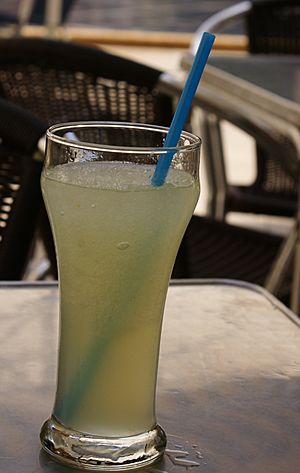
- In Italy, a type of shaved ice is called Grattachecca in Rome, or Granita in Sicily.
- In France, this dessert is called Granité hawaïen.
- In Spain, they are called granizado and are served as a drink with lemon juice.
- In Britain, the term snowball is sometimes used, but it refers to a different treat. The Slush is similar, but it's more for drinking than eating. Both are common in the UK and often sold where ice creams are.
Shaved Ice Drinks
When a lot of liquid is added to shaved ice, it becomes a shaved ice drink.
- Raspado – A Mexican shaved ice drink.
- Sâm bổ lượng – A South Chinese and Vietnamese shaved ice drink or soup with jellies and fruits.
- Cendol – A Southeast Asian drink that usually contains shaved ice.
See also
 In Spanish: Granizado para niños
In Spanish: Granizado para niños


